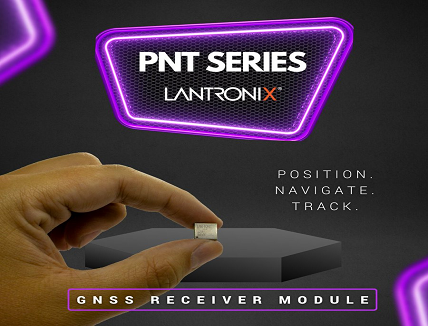
Lantronix new Embedded GNSS Receiver Modules series enables addition of positioning & tracking, navigation, geofencing & timing capabilities to virtually any product
Lantronix launched its new PNT Embedded GNSS Receiver Modules series that provide an easy-to-use, cost-effective solution to enable the addition of GNSS functionality to products.
PNT Embedded GNSS Receiver Modules
The new PNT Embedded GNSS Receiver Modules are appropriate for use in consumer solutions, including people/pet and asset tracking devices as well as agriculture asset monitoring and commercial solutions, such as drones, toll road charging, fleet management, maritime, rail, critical infrastructure, utilities and other applications.
“With the addition of the GNSS receiver modules, Lantronix is expanding its embedded IoT family to meet the growing demand for GNSS capabilities in a wide range of essential, often critical, consumer and commercial applications,” said Brian Jaroszewski, Lead Product Line Manager at Lantronix Inc. “Adding positioning and tracking, navigation and timing capabilities supports essential processes in many industries, empowering our customers to propel our world forward with enhanced safety, security and the increased ability to more effectively and remotely manage people, places and things.”
According to the European Union Agency for the Space Program (EUSPA), by 2031, more than 10 billion GNSS devices will be in use across the world. The dominant role is set aside for the mass market segments of Consumer Solutions, Tourism and Health, which will contribute to 92 percent of all devices in use. The global GNSS downstream market revenues, covering both device sales and service-related revenues, is expected to grow at a CAGR of 9.2 percent over the next decade, reaching a total of USD $486 billion by 2031.
Embedded GNSS Receiver Modules are Available in Two Models
Lantronix PNT-SG3FS
Available now, the PNT-SG3FS flash-based module is designed for simultaneous tracking of multiple constellations. The PNT Embedded GNSS Receiver Modules -SG3FS standalone module integrates a Teseo III receiver from ST Microelectronics. The single-frequency receiver can track up to 32 satellite signals in view across GPS L1C/A, BeiDou B1, Galileo E1B/C, GLONASS L1OF, SBAS L1C/A (WAAS, EGNOS, MSAS, GAGAN) and QZSS L1C/A bands. The pin-compatible multi-frequency PNT-SG4FM adds support for GPS and QZSS L5C, BeiDou B2a and Galileo E5a bands.
The PNT-SG3FS module supports Differential GPS (DGPS) data according to RTCM 10402.3 for improving location accuracy. The module can output measurement data (carrier phase) supporting PPP-RTK host algorithms for precise positioning applications with a custom firmware and supports 1.8V or 3.3V power supply domains. Assisted GNSS algorithms support extended ephemeris data using local autonomous or server-assisted based solutions for fast Time to First Fix (TTFF) operation.
The module provides a high stability pulse-per-second (PPS) output for time-synchronization for electricity transmission, telecom networks operation and timestamping of financial transactions as well as application uses in utility systems, scientific applications, IoT and in broadcast and datacom networks.
The PNT-SG3FS integrates 16MB flash memory that supports many capabilities, including data logging, geofencing, odometer, five-day autonomous assisted GNSS and firmware updates. Integrated is a temperature-compensated crystal oscillator (TXCO) for navigation performance and stability. Also included is a real-time clock (RTC) oscillator with a clock-trimming feature to compensate for the accuracy of the 32.768 kHz crystal in timing applications.
Lantronix PNT-SG4FM
Coming soon, the PNT-SG4FM is a pin-compatible flash-based module designed for multi-frequency GNSS deployments. The PNT-SG4FM is ready for IRNSS using a custom firmware build. The PNT-SG4FM relies solely on server-assisted based Assisted GNSS. In addition, the PNT-SG4FM has a built-in LNA and SAW filter and features short and open circuit detection functions for antenna status.



















